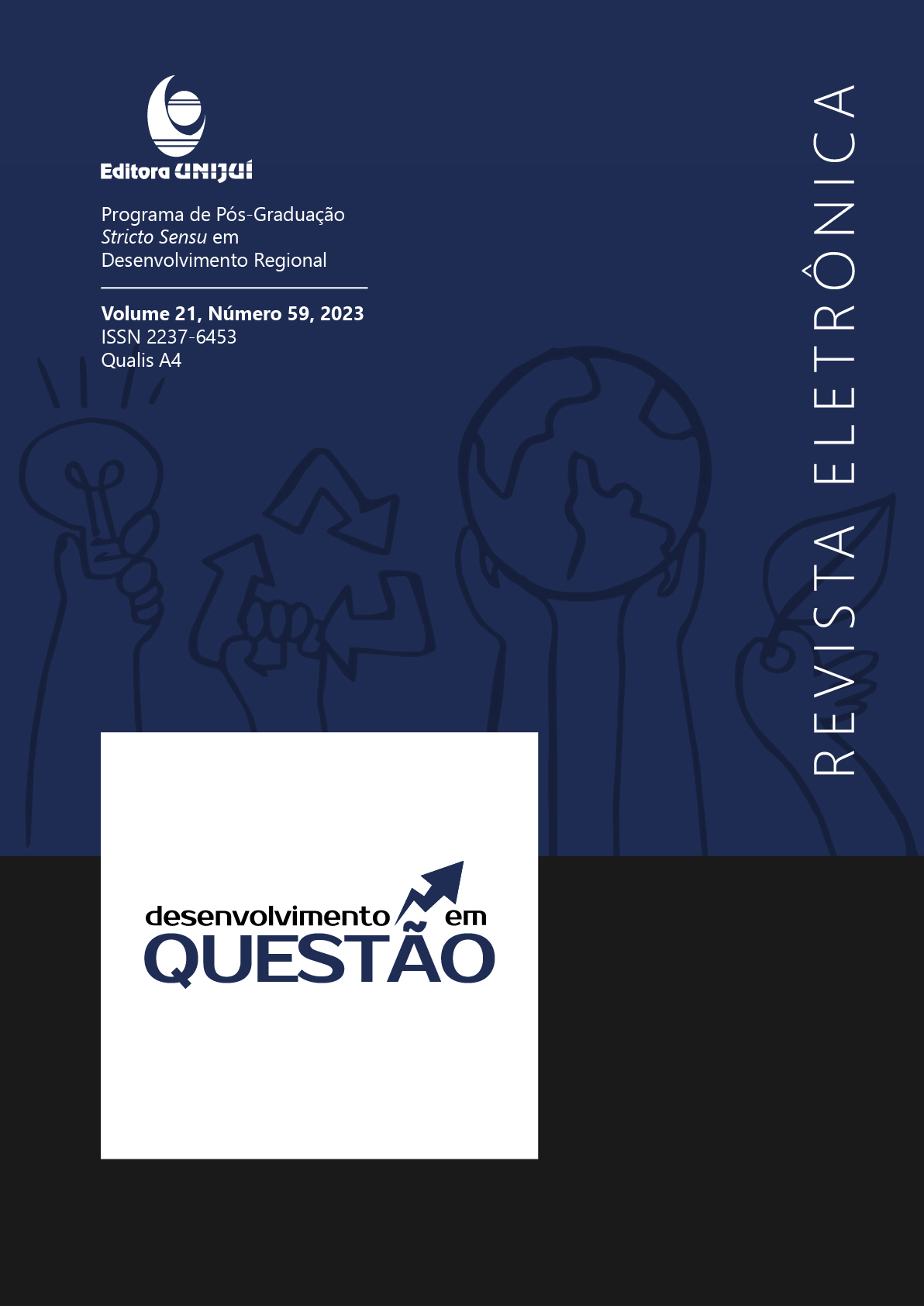Uso da via pública por mulheres: Potencialidades da requalificação urbana
DOI:
https://doi.org/10.21527/2237-6453.2023.59.13446Palavras-chave:
requalificação urbana, caminhabilidade na via pública, inclusão das mulheresResumo
Vias urbanas seguras, acessíveis e inclusivas para mulheres, aproximam-se das metas estabelecidas nas agendas de desenvolvimento global. O centro de Campo Grande/MS tem sido alvo de um programa de revitalização. Uma dessas ações foi a requalificação da Rua 14 de Julho, importante via comercial, com elevada circulação feminina, comprovada por dados de contagem de fluxo de pedestres, cujas intervenções físicas adotaram elementos considerados como necessidades e expectativas femininas. O presente estudo analisa a requalificação de vias, a partir desse case, como potencial alternativa de uso e apropriação por mulheres que vivenciam a cidade a pé. Esta análise foi realizada a partir das ferramentas de contagem e mapeamento, devidamente ajustadas ao contexto da cidade e da via pública requalificada, que serviu de objeto para este estudo. Foi possível constatar diversas iniciativas na requalificação da Rua 14 de julho, que expressam a preocupação com a inclusão das mulheres no seu uso e apropriação por meio dos deslocamentos pedonais.
Referências
BID. Banco Interamericano de Desenvolvimento. As desigualdades de gênero nas cidades. In: Urban 20. Buenos Aires: BID, 2020. Disponível em: https://publications.iadb.org. Acesso em: 30 ago. 2020. DOI: http://dx.doi.org/10.18235/0002241
BORTOLOZZO, C. V. O. Práticas urbanas criativas: estudo, análise e impacto de ações táticas no espaço público paulistano. 2018. 121 f. Dissertação (Mestrado em Arquitetura e Urbanismo) – Universidade Presbiteriana Mackenzie, São Paulo, 2018.
BOURDIEU, P. A dominação masculina. 11. ed. Trad. Maria Helena Kühner. Rio de Janeiro: Bertrand Brasil, 2012.
BRASIL. Lei n. 10.257, de 10 de julho de 2001. Regulamenta os arts. 182 e 183 da Constituição Federal, estabelece diretrizes gerais da política urbana e dá outras providências. Lex: Legislação Federal, Brasília, 2001.
CAMPO GRANDE. Agência Municipal de Meio Ambiente e Planejamento Urbano – Planurb. Perfil Socioeconômico de Campo Grande. 27. ed. Campo Grande: Planurb, 2020.
CAMPO GRANDE. Lei Complementar n. 161, de 20 de julho de 2010. Institui o Plano para Revitalização do Centro de Campo Grande e dá outras providências. Lex: Legislação Municipal, Campo Grande, 2010.
CAMPO GRANDE. Plano de mitigação. Componente I: revitalização do centro. Campo Grande: PMCG; BID, 2018.
CAMPO GRANDE. Plano Local para as Zonas Especiais de Interesse Cultural do Centro – ZEICs Centro: P2 – Diagnóstico. Campo Grande: Organura; Planurb, 2009.
CRUZ, S. S.; PAULINO, S. R. Desafios da mobilidade ativa na perspectiva dos serviços públicos: experiências na cidade de São Paulo. Urbe – Revista Brasileira de Gestão Urbana, Curitiba, v. 11, e20190026, 2019. DOI: https://doi.org/10.1590/2175-3369.011.e20190026
FRANCO, M. J.; CASADEI, J. M . A Requalificação Urbana como garantia de acessibilidade e direitos fundamentais das pessoas idosas. 2020. (Relatório de pesquisa).
GDC. Global Designing Cities Initiatives. Guia Global de Desenho de Ruas. São Paulo: Editora Senac São Paulo, 2018.
GEHL, J. Cities for People. Washington, D. C.: Island Press, 2010.
GEHL, J.; SVARRE, B. A vida na cidade: como estudar. São Paulo: Perspectiva, 2018. 183 p.
GDCI. Global Designing Cities Initiative. Designing Streets for Kids. 216. ed. Nova York: Island Press, 2020. Disponível em: https://globaldesigningcities.org/publication/designing-streets-for-kids/?utm_medium=website&utm_source=archdaily.com.br. Acesso em: 20 abr. 2023.
HELENE, D. Gênero e direito à cidade a partir da luta dos movimentos de moradia. Cadernos Metrópole, São Paulo, v. 21, n. 46, p. 951-974, set./dez. 2019. DOI: http://dx.doi.org/10.1590/2236-9996.2019-4612
HOBBS, J. A. et al. Ruas completas: como implementar mobilidade ativa na sua cidade. BID: Ideação: Inovação em Gestão Pública, 2019. Disponível em: https://blogs.iadb.org/brasil/pt-br/ruas-completas-como-implementar-mobilidade-ativa-na-sua-cidade/. Acesso em: 30 ago. 2020.
IBGE. Cidades e Estados. 2010. Disponível em: https://www.ibge.gov.br/cidades-e-estados/ms/campo-grande.html. Acesso em: 20 jul. 2023.
ITDP. Instituto de Políticas de Transporte e Desenvolvimento. O acesso de crianças e mulheres à cidade. Rio de Janeiro: ITDP, 2018.
JACOBS, J. Morte e vida de grandes cidades. São Paulo: Martins Fontes, 2000.
KRISHNAMURTH, Sukanya et al. Child-Friendly Urban Design: Observations on public space from Eindhoven (NL) and Jerusalem (IL). Haia: Fundação Bernard van Leer, 2018. p. 114.
LEFEBVRE, H. O direito à cidade. São Paulo: Centauro, 2001.
LUGONES, M. Colonialidad y Género. Tabula Rasa, Bogotá, n. 9, p. 73-101, jul./dez. 2008.
LUGONES, M. Rumo a um feminismo descolonial. Estudos Feministas, Florianópolis, v. 22, n. 3, p. 935-952, set./dez. 2014. DOI: https://doi.org/10.1590/S0104-026X2014000300013
MARICATO, E. Habitação social em áreas centrais. Revista Oculum Ensaios, Campinas, n. 1, p. 13-24, 2000.
ONU. Organização das Nações Unidas. Agenda 2030. Brasília: ONU, 2015. Disponível em: https://nacoesunidas.org/pos2015/agenda2030/. Acesso em: 30 ago. 2020.
PADOVANI, E. G. R. A cidade: o espaço, o tempo e o lazer. In: GERARDI, Lucia Helena de Oliveira (org.). Ambientes: estudos de geografia. Rio Claro: Programa de Pós-Graduação e Geografia; Ageteo, 2003. p. 17-183.
RIBEIRO, Andressa; SAMIOS, Ariadne; MANOEL, Paula. Cidade das mulheres: planejamento ignora aspectos cruciais para cidades equitativas. WRI Brasil, São Paulo, 2023. Disponível em: https://www.wribrasil.org.br/noticias/cidade-das-mulheres-planejamento-ignora-aspectos-cruciais-para-cidades-equitativas. Acesso em: 20 abr. 2023.
SAFFIOTI, H. I. B. A mulher na sociedade de classes: mito e realidade. Petrópolis: Vozes, 1978.
SAFFIOTI, H. I. B. Ontogênese e filogênese do gênero: ordem patriarcal de gênero e a violência masculina contra mulheres. In: Série Estudos/Ciências Sociais, Flacso-Brasil, 2009. Disponível em: http://flacso.redelivre.org.br/files/2015/03/Heleieth_Saffioti.pdf. Acesso em: 19 dez. 2020.
SCOTT, J. Gênero: uma categoria útil de análise histórica. Educação & Realidade, Porto Alegre, v. 20, n. 2, p. 71-99, jul./dez. 1995.
SEBRAE. Serviço Brasileiro de Apoio às Micro e Pequenas Empresas. Perfil socioeconômico dos estabelecimentos localizados na Rua 14 de Julho. Campo Grande: Sebrae, 2020.
SECRETARIA MUNICIPAL DE DESENVOLVIMENTO URBANO DA CIDADE DE SÃO PAULO. Mulheres e seus deslocamentos na cidade: uma análise da pesquisa Origem e Destino do Metrô. Informes Urbanos, São Paulo, n. 44, p. 11, mar. 2020. Disponível em: https://www.prefeitura.sp.gov.br/cidade/secretarias/upload/Informes_Urbanos/44_IU_mobilidade_mulheres.pdf. Acesso em: 20 abril 2023.
SILVA, J. M. Gênero e sexualidade na análise do espaço urbano. Geosul, Florianópolis, v. 22, n. 44, p. 117-134, jul./dez. 2007.
VALENÇA, G. C.; SANTOS, E. O conceito de ruas completas e a infraestrutura cicloviária: a experiência de Toronto, Canadá. Revista Espacios, Caracas, Venezuela, v. 39, n. 8, p. 26, 2018.
YAKUPITIYAGE, T. Espaço público seguro para mulheres. ITPS – Agência Envolverde, out. 2015. Disponível em: https://envolverde.com.br/espaco-publico-seguro-para-mulheres/. Acesso em: 2 jun. 2022.
YULE, L. A cidade na escala humana. Campo Grande: Life Editora, 2020.
Downloads
Publicado
Como Citar
Edição
Seção
Licença
Copyright (c) 2023 Desenvolvimento em Questão

Este trabalho está licenciado sob uma licença Creative Commons Attribution 4.0 International License.
Ao publicar na Revista Desenvolvimento em Questão, os autores concordam com os seguintes termos:
Os trabalhos seguem a licença Creative Commons Atribuição 4.0 Internacional (CC BY 4.0), que permite:
Compartilhar — copiar e redistribuir o material em qualquer meio ou formato;
Adaptar — remixar, transformar e criar a partir do material para qualquer fim, inclusive comercial.
Essas permissões são irrevogáveis, desde que respeitados os seguintes termos:
Atribuição — Atribuição — os autores devem ser devidamente creditados, com link para a licença e indicação de eventuais alterações realizadas.
Sem restrições adicionais — não podem ser aplicadas condições legais ou tecnológicas que restrinjam o uso permitido pela licença.
Avisos:
A licença não se aplica a elementos em domínio público ou cobertos por exceções legais.
A licença não garante todos os direitos necessários para usos específicos (ex.: direitos de imagem, privacidade ou morais).
A revista não se responsabiliza pelas opiniões expressas nos artigos, que são de exclusiva responsabilidade dos autores. O Editor, com o apoio do Comitê Editorial, reserva-se o direito de sugerir ou solicitar modificações quando necessário.
Somente serão aceitos artigos científicos originais, com resultados de pesquisas de interesse que não tenham sido publicados nem submetidos simultaneamente a outro periódico com o mesmo objetivo.
A menção a marcas comerciais ou produtos específicos destina-se apenas à identificação, sem qualquer vínculo promocional por parte dos autores ou da revista.
Contrato de Licença (para artigos publicados a partir de 2025): Os autores mantêm os direitos autorais sobre seu artigo, e concedem a Revista Desenvolvimento em Questão o direito de primeira publicação.











